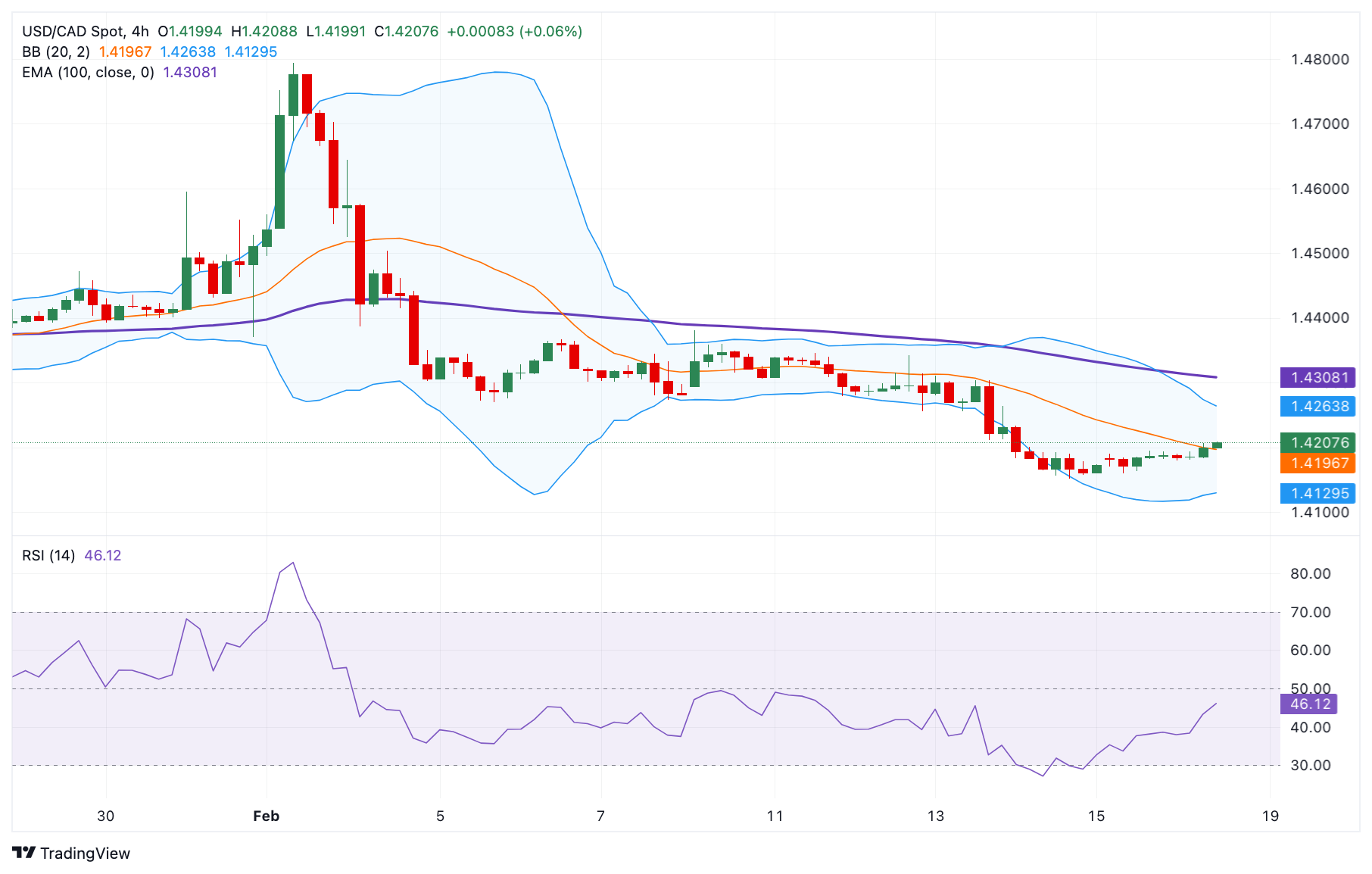- USD/CAD gathers strength to around 1.4205 in Tuesday’s early European session.
- The pair keeps the negative view below the 100-period EMA with the bearish RSI indicator.
- The first downside target to watch is 1.4151; the immediate resistance level emerges near 1.4265.
The USD/CAD pair trades in positive territory near 1.4205 during the early European session on Tuesday, supported by the firmer Greenback. The Canadian Consumer Price Index (CPI) inflation data for January will be the highlight later on Tuesday.
The headline CPI is estimated to show an increase of 1.8% YoY in January. On a monthly basis, the CPI inflation is projected to rise to 0.1% in January from a decline of 0.4% in December.
According to the 4-hour chart, the bearish outlook of USD/CAD prevails as the pair is below the key 100-period Exponential Moving Average (EMA). The downward momentum is reinforced by the Relative Strength Index (RSI), which stands below the midline near 46.25, supporting the sellers in the near term.
The initial support level for the cross is seen at 1.4151, the low of February 14. Any follow-through selling below the mentioned level could see a drop to 1.4130, the lower limit of the Bollinger Band. Further south, the next contention level to watch is the 1.4100 psychological level.
The first upside barrier for the pair emerges near 1.4265, the upper boundary of the Bollinger Band. A decisive break above this level could pave the way to 1.4310, the 100-period EMA. Extended gains could see a rally to the next hurdle at 1.4380, the high of February 10.
USD/CAD 4-hour chart

Canadian Dollar FAQs
The key factors driving the Canadian Dollar (CAD) are the level of interest rates set by the Bank of Canada (BoC), the price of Oil, Canada’s largest export, the health of its economy, inflation and the Trade Balance, which is the difference between the value of Canada’s exports versus its imports. Other factors include market sentiment – whether investors are taking on more risky assets (risk-on) or seeking safe-havens (risk-off) – with risk-on being CAD-positive. As its largest trading partner, the health of the US economy is also a key factor influencing the Canadian Dollar.
The Bank of Canada (BoC) has a significant influence on the Canadian Dollar by setting the level of interest rates that banks can lend to one another. This influences the level of interest rates for everyone. The main goal of the BoC is to maintain inflation at 1-3% by adjusting interest rates up or down. Relatively higher interest rates tend to be positive for the CAD. The Bank of Canada can also use quantitative easing and tightening to influence credit conditions, with the former CAD-negative and the latter CAD-positive.
The price of Oil is a key factor impacting the value of the Canadian Dollar. Petroleum is Canada’s biggest export, so Oil price tends to have an immediate impact on the CAD value. Generally, if Oil price rises CAD also goes up, as aggregate demand for the currency increases. The opposite is the case if the price of Oil falls. Higher Oil prices also tend to result in a greater likelihood of a positive Trade Balance, which is also supportive of the CAD.
While inflation had always traditionally been thought of as a negative factor for a currency since it lowers the value of money, the opposite has actually been the case in modern times with the relaxation of cross-border capital controls. Higher inflation tends to lead central banks to put up interest rates which attracts more capital inflows from global investors seeking a lucrative place to keep their money. This increases demand for the local currency, which in Canada’s case is the Canadian Dollar.
Macroeconomic data releases gauge the health of the economy and can have an impact on the Canadian Dollar. Indicators such as GDP, Manufacturing and Services PMIs, employment, and consumer sentiment surveys can all influence the direction of the CAD. A strong economy is good for the Canadian Dollar. Not only does it attract more foreign investment but it may encourage the Bank of Canada to put up interest rates, leading to a stronger currency. If economic data is weak, however, the CAD is likely to fall.
Information on these pages contains forward-looking statements that involve risks and uncertainties. Markets and instruments profiled on this page are for informational purposes only and should not in any way come across as a recommendation to buy or sell in these assets. You should do your own thorough research before making any investment decisions. FXStreet does not in any way guarantee that this information is free from mistakes, errors, or material misstatements. It also does not guarantee that this information is of a timely nature. Investing in Open Markets involves a great deal of risk, including the loss of all or a portion of your investment, as well as emotional distress. All risks, losses and costs associated with investing, including total loss of principal, are your responsibility. The views and opinions expressed in this article are those of the authors and do not necessarily reflect the official policy or position of FXStreet nor its advertisers. The author will not be held responsible for information that is found at the end of links posted on this page.
If not otherwise explicitly mentioned in the body of the article, at the time of writing, the author has no position in any stock mentioned in this article and no business relationship with any company mentioned. The author has not received compensation for writing this article, other than from FXStreet.
FXStreet and the author do not provide personalized recommendations. The author makes no representations as to the accuracy, completeness, or suitability of this information. FXStreet and the author will not be liable for any errors, omissions or any losses, injuries or damages arising from this information and its display or use. Errors and omissions excepted.
The author and FXStreet are not registered investment advisors and nothing in this article is intended to be investment advice.
Editors’ Picks

EUR/USD declines toward 1.0450 on USD recovery
EUR/USD struggles to gain traction and declines toward 1.0450 on Tuesday despite the upbeat ZEW Survey – Economic Sentiment data for Germany and the Eurozone. Rising US Treasury bond yields support the US Dollar and weigh on the pair.
EUR/USD News

GBP/USD struggles to hold above1.2600
GBP/USD stays under modest bearish pressure and trades below 1.2600 on Tuesday. Earlier in the day, the pair edged higher with the initial reaction to the UK labor market data, which showed that the Unemployment Rate held steady at 4.4% in the three months to December.
GBP/USD News

Gold gathers bullish momentum, rises to $2,920 area
Gold builds on Monday’s modest gains and rises to the $2,920 area on Tuesday. Markets brace for headlines to come in from Saudi Arabia, where US and Russian officials are meeting for peace talks. Meanwhile, rising US T-bond yields could limit XAU/USD’s upside.
Gold News

Why Solana, XRP, Dogecoin and BNB are crashing?
Solana (SOL), XRP, Dogecoin (DOGE) and Binance Coin (BNB) decline on Tuesday. Top altcoins ranked by market capitalization are in a downward trend, even though Bitcoin (BTC) continues to consolidate around the $95,000 level.
Read more

Rates down under
Today all Australian eyes were on the Reserve Bank of Australia, and rates were cut as expected. RBA Michele Bullock said higher interest rates had been working as expected, slowing economic activity and curbing inflation, but warned that Tuesday’s first rate cut since 2020 was not the start of a series of reductions.
Read more

The Best Brokers of the Year
SPONSORED Explore top-quality choices worldwide and locally. Compare key features like spreads, leverage, and platforms. Find the right broker for your needs, whether trading CFDs, Forex pairs like EUR/USD, or commodities like Gold.
Read More









